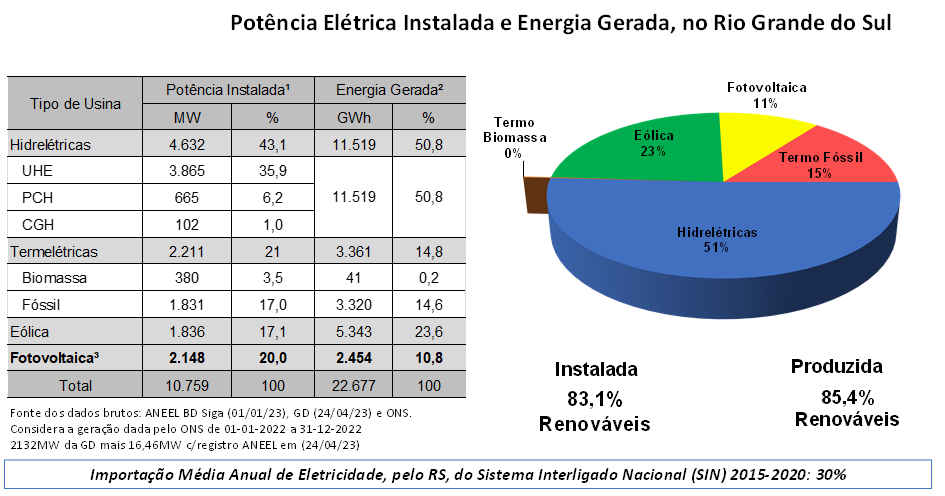Renewable energy
Brazil is one of the world leaders in the use of renewable energy sources. While the global energy matrix comprises only 13.5% of renewable sources, in Brazil this share jumps to 43.5% (EPE). In recent years, in addition to water sources, other renewable sources such as wind and biofuels have expanded their presence in the energy matrix, making room for the creation of new production chains, job creation and technological development. Rio Grande do Sul stands out in the development of wind sources, biodiesel and small hydroelectric plants (PCHs). More recently, the private sector and the State Government have also invested in the development of photovoltaic sources.
In parallel, the increasing integration of clean energies into the energy matrix contributes to the reduction of greenhouse gases (GHG), establishing the conditions for the country to fulfill the commitments signed in the Paris Agreement, resulting from the United Nations Conference on Climate Change – COP 21, in 2015. The Paris Agreement provides for the reduction of GHG emissions by 37% for 2025 and 43% for 2030, based on emissions in 2005. For this purpose, the Nationally Determined Contributions (CND) ) in Brazil have the goal of expanding the share of renewable energies to 45% and bioenergy to 18% by 2030 (MMA).
The growth of renewable energies in the world and, in particular, in the country, opens a window of opportunities and places energy as one of the most dynamic economic sectors. According to the Ministry of the Environment (MMA), the financing of the commitments assumed by the signatory countries of the Paris Agreement will move approximately U$ 100 billion per year.
The main institutions responsible for planning, regulating and researching the energy sector establish growth scenarios for the supply of renewable energies with targets that go beyond those related to the Paris Agreement. The Energy Development Plan (PDE) indicates that, for 2026, the Brazilian energy matrix will have 48% of renewable sources. PCHs, biomass, photovoltaic and wind will grow 120%, with their installed capacity evolving from 28.7 GW, in 2016, to 63.2 GW, in 2026. In the time horizon of the PDE, wind energy will reach 28.47 GW, and solar energy, still incipient, could reach 9.6 GW (EPE, PDE 2026).
The Secretariat for the Environment and Infrastructure has been working to promote sustainable energy development in the State, in such a way that it serves the various segments of the Rio Grande do Sul community, through actions that support generation projects and the needs of energy consumption.
Rio Grande do Sul has great energy potential in wind, solar, biomass and water renewable sources, the first three being portrayed through some of their maps contained in the respective atlases.

Figure: Maps of wind, biomass and solar energy potentials
The state's electricity matrix, which has always had a predominance of water resources, had, as of 2006, the insertion of wind energy, which today represents 18.4% of the total installed power. Currently, renewable energies represent 81.7% of the installed power and 81.4% of the energy produced. About 30% of the electricity consumed in RS is imported from the National Interconnected System.
 Figure: Installed Power and Energy Produced in Rio Grande do Sul
Figure: Installed Power and Energy Produced in Rio Grande do Sul